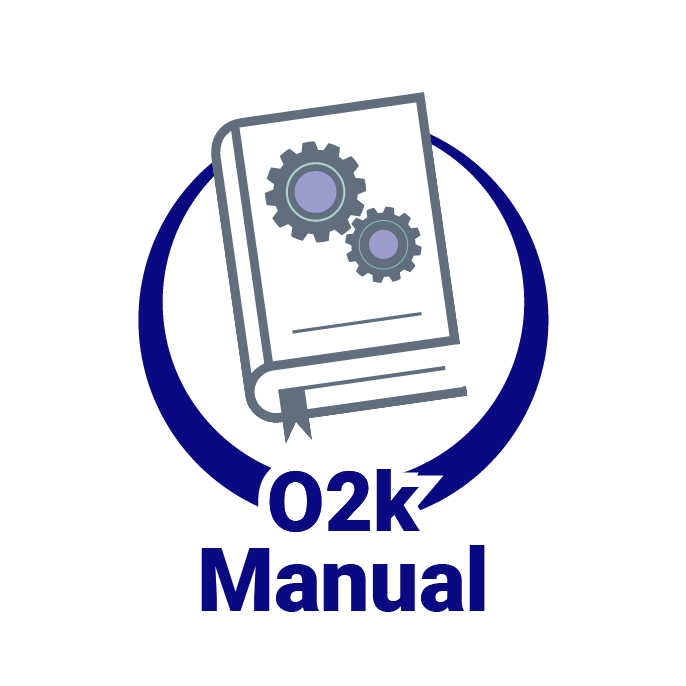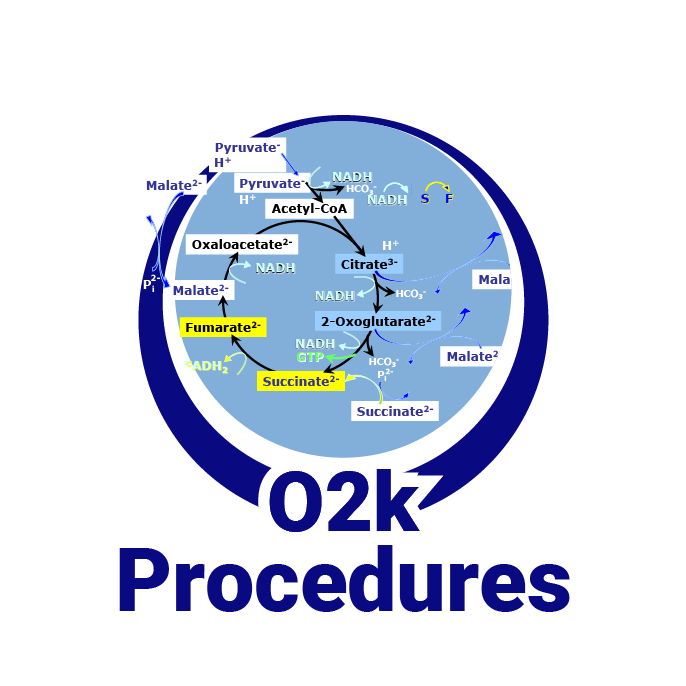Difference between revisions of "Talk:Setting the oxygen concentration"
| Line 10: | Line 10: | ||
With MiR06 (or [[MiR06Cr]]), the medium in the O2k-chamber can be re-oxygenated very conveniently with H<sub>2</sub>O<sub>2</sub> titrations. The initial increase in oxygen, however, is preferentially made with oxygen gas, since there is the risk of bubble formation if the oxygen concentration is increased in a single large step. If oxygen gas is not available for the initial oxygenation, a very small bubble may be left in the chamber while slowly rising the oxygen level to 500 µM with additions of H<sub>2</sub>O<sub>2</sub>, such that gas can escape into the small bubble and then be extruded by fully closing the chamber. During the experiment, re-oxygenations are sufficiently small such that H<sub>2</sub>O<sub>2</sub> titrations into the closed chamber do not lead to gas bubble formation. | With MiR06 (or [[MiR06Cr]]), the medium in the O2k-chamber can be re-oxygenated very conveniently with H<sub>2</sub>O<sub>2</sub> titrations. The initial increase in oxygen, however, is preferentially made with oxygen gas, since there is the risk of bubble formation if the oxygen concentration is increased in a single large step. If oxygen gas is not available for the initial oxygenation, a very small bubble may be left in the chamber while slowly rising the oxygen level to 500 µM with additions of H<sub>2</sub>O<sub>2</sub>, such that gas can escape into the small bubble and then be extruded by fully closing the chamber. During the experiment, re-oxygenations are sufficiently small such that H<sub>2</sub>O<sub>2</sub> titrations into the closed chamber do not lead to gas bubble formation. | ||
* '''Increase oxygen levels with pure oxygen''' | |||
If you replace the air phase above the liquid phase by pure oxygen you can increase oxygen levels above air saturation, as it is recommended for measuring mitochondrial respiratory function in muscle biopsies. | |||
:* [[Open chamber]]: Before injecting oxygen gas, the O2k-Chamber needs to be opened to obtain a defined gas volume above the aqueous phase. | |||
:* [[Syringe\60 ml\Gas-Injection | 60 mL syringe]] pure oxygen is injected into the gas phase of the O2k-Chamber. | |||
:* Close the chamber when the O<sub>2</sub> concentration approaches the desired O<sub>2</sub> level. | |||
*'''Re-oxygenation by adding H<sub>2</sub>O<sub>2</sub> to a catalase containing medium (Medium-MiR06)''' | *'''Re-oxygenation by adding H<sub>2</sub>O<sub>2</sub> to a catalase containing medium (Medium-MiR06)''' | ||
| Line 19: | Line 25: | ||
:Lift the stopper and leave a gas volume above the liquid phase (use the stopper-spacer tool to set the stopper in the right position). Leave the chamber open till oxygen is again up to approximately air calibration level. Close the chamber by inserting the stopper completely and wait till the sensor is stable again (may take 5 to 10 minutes). | :Lift the stopper and leave a gas volume above the liquid phase (use the stopper-spacer tool to set the stopper in the right position). Leave the chamber open till oxygen is again up to approximately air calibration level. Close the chamber by inserting the stopper completely and wait till the sensor is stable again (may take 5 to 10 minutes). | ||
:If possible, it is preferable to re-oxygenate in a phase of low respiratory activity, only little amounts of oxygen are consumed during the stabilization phase of the sensor after closing the chamber. | :If possible, it is preferable to re-oxygenate in a phase of low respiratory activity, only little amounts of oxygen are consumed during the stabilization phase of the sensor after closing the chamber. | ||
=== Decreasing the oxygen concentration === | === Decreasing the oxygen concentration === | ||
Revision as of 10:38, 8 June 2020
 |
Talk:Setting the oxygen concentration |
MitoPedia O2k and high-resolution respirometry:
O2k-Open Support
The oxygen concentration can be increased or decreased during an experiment with biological sample, depending on the desire approach (hypoxia, working with muscle fibers...) or simply if the experiment is not done and the oxygen went low.
Increasing the oxygen concentration
It is always possible to increase the oxygen concentration using the combination of catalase in the medium and injections of H2O2, as described in MiPNet14.3. By using the TIP2k the oxygen concentration can be maintained between well defined limits, either using H2O2 or (for very low oxygen concentrations) air saturated medium in the TIP syringes. We call this an "oxystat" approach and supply appropriate templates for controlling the TIP2k. See also MiPNet12.10.
An experiment needs not necessarily be terminated, because of running out of oxygen. There are different possibilities to re-oxygenate.
- To increase oxygen levels small volumes (µL) of 200 mM H2O2 stock solution are injected into the O2k-chamber filled with 2 mL MiR06.
With MiR06 (or MiR06Cr), the medium in the O2k-chamber can be re-oxygenated very conveniently with H2O2 titrations. The initial increase in oxygen, however, is preferentially made with oxygen gas, since there is the risk of bubble formation if the oxygen concentration is increased in a single large step. If oxygen gas is not available for the initial oxygenation, a very small bubble may be left in the chamber while slowly rising the oxygen level to 500 µM with additions of H2O2, such that gas can escape into the small bubble and then be extruded by fully closing the chamber. During the experiment, re-oxygenations are sufficiently small such that H2O2 titrations into the closed chamber do not lead to gas bubble formation.
- Increase oxygen levels with pure oxygen
If you replace the air phase above the liquid phase by pure oxygen you can increase oxygen levels above air saturation, as it is recommended for measuring mitochondrial respiratory function in muscle biopsies.
- Open chamber: Before injecting oxygen gas, the O2k-Chamber needs to be opened to obtain a defined gas volume above the aqueous phase.
- 60 mL syringe pure oxygen is injected into the gas phase of the O2k-Chamber.
- Close the chamber when the O2 concentration approaches the desired O2 level.
- Re-oxygenation by adding H2O2 to a catalase containing medium (Medium-MiR06)
- Add catalase at a final concentration of 280 IU/mL to the medium at the beginning of an experiment. When oxygen starts to become limited, inject 1-3 µL of an approximately 200 mM H2O2 stock solution. The H2O2 will immediately be degraded to O2; the catalase concentration is high enough to avoid any oxidative stress. In this approach the chamber is not opened and closed, so the disturbance of the system is less and the stabilization phase of the sensor is short compared to a re-oxygenation by opening the chamber.
- Re-oxygenation by opening the chamber
- Lift the stopper and leave a gas volume above the liquid phase (use the stopper-spacer tool to set the stopper in the right position). Leave the chamber open till oxygen is again up to approximately air calibration level. Close the chamber by inserting the stopper completely and wait till the sensor is stable again (may take 5 to 10 minutes).
- If possible, it is preferable to re-oxygenate in a phase of low respiratory activity, only little amounts of oxygen are consumed during the stabilization phase of the sensor after closing the chamber.
Decreasing the oxygen concentration
Reach low oxygen levels in a biological experiment may be done by inserting a N2 bubble into the chamber, waiting until the desired level of oxygen is reached and then destroying the air bubble by closing the stoppers, see how in: Nitrogen injection. However, most often the desired starting value is simply reached by waiting until the sample has consumed the required amount of oxygen and then starting the "oxystat".
For calibration and instrumental oxygen background purposes we use Dithionite to reduce oxygen levels, however this is not recommended in the presence of biological samples.




